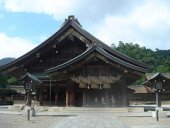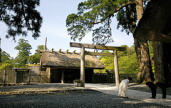Shinto in Japan

Shinto in Japan |
 |
What is Shinto? |
TOP > Japanese religion > Shinto
Shinto: One of Japanese major religions I would like to introduce you Shinto, one of Japanese major religions in this page. From ancient time, there has been a thought of syncretization of Shinto and Buddhism in Japan, so you may find Buddhism elements in Shinto Shrine and vice versa. Please remind it when you visit Shinto Shrine. What is Shinto (Shintoism) The origin of Shinto is in Japan. Because they originally regarded the nature and natural phenomenon as Gods, there were innumerable Gods and they are called 'Yaoyorozuno Kami (Eight million Gods)' They gradually became to worship their ancestors. This is the process of the development of Shinto, so there is no founder nor the scriptures. Japanese mythology also affected Shinto. Japanese mythology was organised from 'Kojiki' and 'Nihonshoki' written in 8th century. The story started from the birth of Gods in Takamagahara. The ancestry leads to the first Emperor Jimmu. By this reason, many Shrines enshrine the Gods derived from mythology and Emperor also became the object of worship because he was regarded the descendent of Gods. Even now, Emperor operates many shrine rituals though Emperor declared himself as a human being after the Second World War. What is Shrine (Jinja) Shrine is a religious institute based on Shinto belief. The origin of Shrine was an temporary altar which was set in the holy place (God's mountain) for the religious ritual. After Buddhism were imported, the pavillions started to be built by its influence. Now, thre are about 85,000 Shrines in Japan.  Around the Shrine generally is a holy forest called 'Chinjuno Mori' At the entrance, there is Shrine gate called 'Torii' which indicates the border between holy place and secular world. Then approach stretches to the pavillion. On the way, there are place to purifying with the water, offices and so on. The pavillions generally consist of Honden (or Shinden, main hall) and Haiden (hall of worship). We normally see Haiden when we go worship. Honden where God is enshrined situates behind Haiden. In Nara era (8th century) when cyncretization of Shinto and Buddhism started, Temple (called Jinguji) was built in the ground of Shrine. After Meiji era (19th century) by the order of the government to separate Shinto and Buddhism, Shrine and Temple have separated. Architectual style of Shrine The main characteristics of architectual styles of Shrine are as follows. 1. Ridge roof. 2. High floor. 3. No use of tile. 4. No use of clay wall. 5. Simple decoration. There are 2 architectual styles 'Tumairi' and 'Hirairi'. It is determined by the position of the entrance relative to the ridge of the roof.  Examples of Tsumairi style - Izumo Taisha (Izumo City, Shimane) - Kasuga Taisha (Nara City, Nara) - Sumiyoshi Taisha (Shimonoseki City, Yamaguchi) - Otori Jinja (Sakai City, Osaka) Examples of Hirairi style  - Ise Jingu (Ise City, Mie) - Kamo Jinja (Kyoto City, Kyoto) - Itsukushima Jinja (Hatsukaichi City, Hiroshima) - Mikami Jinja (Yasu City, Shiga) - Hiyoshi Taisha (Otsu City, Shiga) - Usa Jingu (Usa City, Oita) |
 Itsukushima Jinja in Hiroshima - Shinto - Buddhism |
| Copyright(C) Let's Travel in Japan! All Rights Reserved |